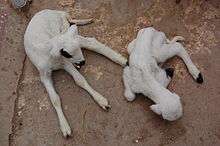Border disease
Border disease (BD) is a viral disease of sheep and goats, primarily causing congenital diseases, but can also cause acute and persistent infections. It first appeared in the border regions of England and Wales in 1959, and has since spread world-wide. Lambs that are born with BD are commonly known as 'hairy shakers' due to the primary presentation of the disease. The disease was recognized before the virus, therefore the common name of the disease predates the understanding of the viral taxonomy. The virus can cause a significant reduction in the percentage of surviving lambs, thus it has a large economic impact on farmers.[2]
| Pestivirus D | |
|---|---|
| Virus classification | |
| (unranked): | Virus |
| Realm: | Riboviria |
| Phylum: | incertae sedis |
| Family: | Flaviviridae |
| Genus: | Pestivirus |
| Species: | Pestivirus D |
| Synonyms.[1] | |
|
Border disease virus | |
Virus
Border disease is caused by Pestivirus D, formerly called Border disease virus, in the family Flaviviridae. Although it is the same virus causing the disease, the name was officially changed in 2018 by the International Committee on Taxonomy of Viruses.[3] This has changed the genus from host organized to divergence of complete coding nucleotide sequences by more than 25%. This was proposed as less confusing, given that the viruses are not host exclusive.[1]
It is a single stranded RNA virus that is labile in the environment.
Epidemiology
Transmission is vertical or horizontal by nose to nose contact. The main source of infection is persistently infected animals. While border disease is caused by border disease virus (BDV), in areas of the world where close contact between sheep and goats and cattle occurs, similar clinical signs may be caused in sheep and goats by bovine viral diarrhea virus (BVDV).[4] It is therefore important to identify truly infected animals through direct detection of the virus or nucleic acid in blood or tissues or by precise virus isolation in cell culture with immunostaining to detect the noncytopathogenic virus.[2]
Vaccination
There is currently no vaccine available in the UK, but there are vaccines available in the USA and other areas of Europe. While there are vaccines available, none are proven efficacious. BVDV vaccines for cattle have been used, but can not be recommended because the viruses are antigenic ally distinct.[5]
Control is established through blood testing sheep and culling seropositive animals.[2]
Clinical Signs

While Border disease primarily causes congenital issues, it can also manifest as acute infection or persistent infection.
Acute Infection
Most healthy animals will only experience subclinical disease or very mild infection. A slight fever and a mild leukopenia may be seen with a short-lived viremia, detectable between days 4-11 post infection, at which point the virus is neutralized by the animal's immune system.[6]
Fetal Infection
While the level of evident maternal infection may be minimal, the consequences for the fetus are serious before day 85 of gestation. After day 85, the lamb is most likely to be born normal with antibodies to BDV, given the state of the fetal immune system at this stage in gestation.
Fetal infection manifests as four syndromes:
- Early Embryonic Mortality
- Abortion and Stillbirth
- Congenital Malformation
- Birth of small weak lambs with immunosuppression
The animals that do survive to live birth will frequently show the 'hairy shaker' signs. The virus has a tropism for fetal lymphoid tissue, hair follicles, and the central nervous system. The 'hairy shakers' are born with hair (not wool) and the shaking comes from cerebellar hypoplasia.[5]
Persistent viraemia
Feti that are infected between 60–85 days of gestation have a 50% chance of survival. The fetus is not immunocompetent at this stage and viral replication within fetal tissues is uncontrolled. Feti that survive infection at this stage of gestation will be tolerant of the virus and their immune system will not properly respond to it. As such there is no inflammatory response, but the characteristic 'hairy shaker' changes are still present. Some animals will continue to survive with viremia, while most will die by 6 months of age.[7]
Diagnosis
Diagnosis is made through observation of clinical signs, presence of disease in the area, and confirmation made by serology: ELISA for virus antigen[8]
References
- Smith, Donald B.; et al. (31 May 2017). "Renaming four species and creating seven new species in the genus Pestivirus" (zip). ICTV Proposal. Retrieved 19 August 2019.
...Border disease virus becomes Pestivirus D.
- "Manual of Diagnostic Tests and Vaccines for Terrestrial Animals". OIE. 2018.
- King, Andrew M. K.; et al. (12 May 2018). "Changes to taxonomy and the International Classification and Nomenclature ratified by the International Committee on Taxonomy of Viruses". Archives of Virology. 163 (9): 2601–2631. doi:10.1007/s00705-018-3847-1. PMID 29754305.
- Carlsson U (1991). "Border disease in sheep caused by transmission of virus from cattle persistently infected with bovine virus diarrhoea virus". Vet. Rec. 128 (7): 145–147. doi:10.1136/vr.128.7.145. PMID 1851350.
- Callan, Robert. "Border Disease (Hairy Shaker Disease)".
- Thabti F, Fronzaroli L, Dlissi E, Guibert JM, Hammai S, Pepin M, Russo P (2002). "Experimental model of border disease virus infection in lambs: comparative pathogenicity of pestiviruses isolated in France and Tunisia". Vet Res. 33 (1): 35–45. doi:10.1051/vetres:2001004. PMID 11873817.
- Nettleton PF, Gilray JA, Russo P, Dlissi E (1998). "Border disease of sheep and goats". Vet Res. 29 (3–4): 327–340. PMID 9689745.
- Radostits, Otto M.; Gay, Clive C.; Blood, Douglas C.; Hinchcliff, Kenneth W. (2000). Veterinary Medicine: A Textbook of the Diseases of Cattle, Sheep, Pigs, Goats and Horses (9th ed.). Elsevier Health Sciences. ISBN 9780702026041.